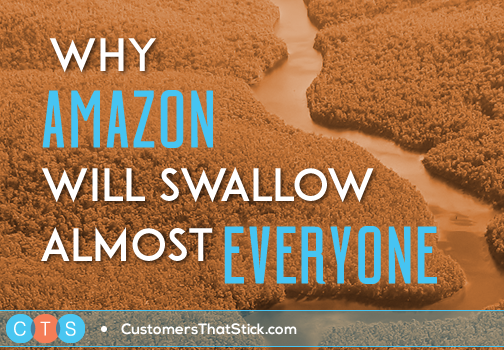Amazon. The name itself perfectly captures the essence of what the company has become.

It is the largest, dominant feature in its ecosphere. It provides sustenance to those who use its resources. It serves as an economic engine for those whose livelihoods center around it. And nearby bodies of water feed it more than they compete with it.
A few recent interactions with Amazon demonstrate how the company is slowly but surely going to swallow almost everyone. While these examples are certainly anecdotal, they seem to exemplify larger trends in Amazon’s continued growth and increasing dominance.
We needed a new suitcase, and our options were simple:
Or, as Prime members, we could go to Amazon, buy the exact suitcase we wanted in two clicks of a mouse, and have it arrive in two days with no shipping charge.
So, that is what we opted to do, except it didn’t take two days, or even one day; we received our bag the same day.
Though we are all becoming less surprised by and more accepting of such immediacy, it is significant to note that we didn’t purchase obvious items like paper towels, tee shirts, or toothpaste. We purchased a large piece of luggage from a mid-sized luggage brand.
And we received it from Amazon the same day. On a Saturday. Shipped for free.
I’m a creature of retail, and I can only lament what this means for too many brick and mortar concepts over the long term.
And it get’s worse.
Our next experience with Amazon around the same time was when we discovered Thrive Market. My wife and I try to eat fairly healthfully and had both coincidentally been separately exposed to the existence of Thrive Market within a week’s period of time.
When we went to the site, we were presented with a hard sales squeeze page in place of the home page. In other words, you couldn’t even browse Thrive’s website and offerings without giving up an email address.
Fortunately, having run my own blog for many years, I knew enough to bypass the gate to look through the site. Most consumers wouldn’t have.
Thrive Market has a membership model, in which you pay an annual fee and have access to supposedly discounted items. As we browsed through the items available, my wife kept noticing that many of the items didn’t seem that inexpensive.
So, we decided to check Amazon to compare prices.
You can probably guess where this is going…
And while I did not scientifically study whether Thrive is less expensive than Amazon across a representative sample of products, across the wide variety of items that we buy, Amazon was at par with Thrive or significantly cheaper.
What was more significant in this process was that we discovered just how much we were overpaying for items that we buy at Target, Publix or Whole Foods, and as a result, we moved a significant portion of our shopping for basic necessities to Amazon. And I don’t mean Amazon Pantry, which I find byzantine, but we moved that shopping to standard Amazon using the Prime mechanism.
After 17 years as an Amazon customer, it has now become my preferred vendor for a significant portion of groceries and basic necessities, a transformation that is becoming increasingly true for millions of consumers.
Amazon is winning the slow war for share of wallet.
Amazon Prime may go down as one of the most brilliant business strategies of the 21st Century. Besides adding hundreds of millions in recurring subscription revenue to Amazon’s top line, Amazon benefits in many other ways:
However, to me, Amazon’s ability to shop-block both its rivals and brands is Prime’s greatest advantage. Look at our experience with Thrive Market. What value proposition would Thrive had needed to get us to pay another annual membership fee to shop online?
Putting aside the terrible user experience and first impression of the gated home page, Thrive would have needed killer online reviews and significantly better pricing. It had neither.
The true brilliance of Prime is that it has conditioned its members to check Amazon first.
Why pay more and wait longer for shipping? Why deal with another account setup? Why roll the dice on an unfamiliar user and customer experience?
This not only destroys competitors, both online and off, an obvious fact which many have focused on, but less obviously, it interrupts the relationship brands have with their customers, thus making it more difficult and expensive to maintain those direct relationships with customers.
Every time a consumer, particularly a Prime member, opts for the convenience of their Amazon account over purchasing directly from a brand’s website itself, Amazon is strengthening their relationship with the consumer and blocking the relationship between the brand and the customer.
During the transaction itself, the brand is getting less screen share and, worse, through Amazon’s recommendation engine, might even have competitive brands’ products being recommended and possibly losing the sale as a result.
After the transaction, the brand, whether it be Tommy Hilfiger or Samsonite, may get little information about the purchaser, and certainly not the opt-in, direct access communication pipeline that would have come had the customer purchased through the brand’s site.
For the brand, particularly for customers new to the brand, the customer now has a relationship with the product and not with the brand itself.
After the customer’s cash, Amazon keeps the second most valuable resource of all — the customer’s attention, and that is how Amazon will eventually swallow almost everyone.
In case you’re interested, we’ve written about and discussed Amazon before:
Comments have been closed on this post.
© 2011-2023 CTS Service Solutions, LLC.
All rights reserved.
Legal Information | Privacy Policy
How to Cite this Site
Amazon is a beast, indeed.
So true Stan!
Pingback: 153: Training for New Customer Service Technology